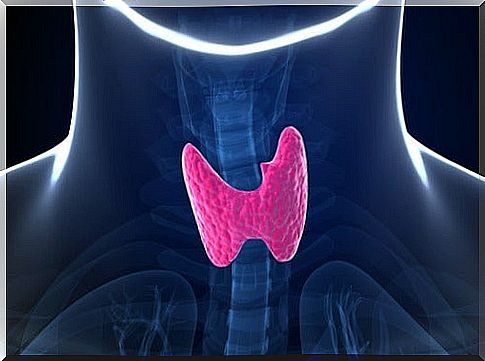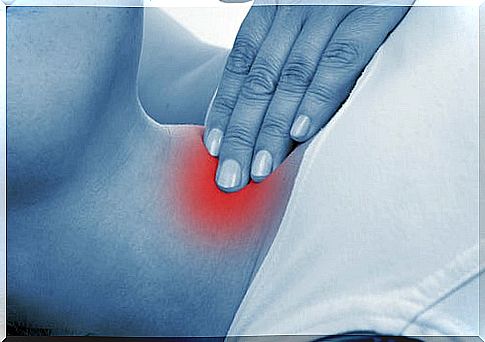Goiter: Inflammation Of The Thyroid
Thyroid problems are inherited, and affect women more than men. Goiter is one of the disorders that derive from it. This is the most well-known damage to the thyroid gland.
Read the rest of this article if you want to learn more about this topic.
Thyroid: questions and answers
Receiving the right information about the thyroid gland is the first step towards prevention. Here are the answers to some of the most asked questions:
- What is the thyroid and what is its function?
It is a gland that weighs 20 grams, and is located at the base of the neck, on the sides of the trachea. Its role is to synthesize, store and release two hormones, thyroxine (T4) and triiodothyronine (T3). These contribute to the proper functioning of cells. - What are the most common thyroid-related diseases?
Goiter, which is an increase in the size of this gland. Most nodules that get bigger are benign, but you still need a medical exam to determine this.
When the levels of thyroid hormones in the blood decrease, this phenomenon is called hypothyroidism. Conversely, when they increase, it is called hyperthyroidism. It goes without saying that not all people with thyroid problems have goiter. - What are the symptoms of thyroid gland disorders?
Nodules are lumps in the neck that can be discovered by the patient while washing, applying makeup, or shaving. When they reach a considerable size, they cause difficulty in swallowing or breathing, and even voice changes.

- Does this pathology affect the entire population without distinction?
Disorders of the thyroid gland are six times more common in women. They often present after menopause, or after forty years. - What factors are associated with thyroid gland disorders?
Nodules appear more generally in geographic areas poor in iodine, when there is a family history.
When the person has had radiation treatments to the neck in childhood, when they are gaining weight. When she suffers from autoimmune diseases like vitiligo, type 1 diabetes, psoriasis, rheumatoid arthritis.
At the root of its disorders are external triggers such as stress, smoking, bacterial or viral infections, treatment with any medication, or short-term iodine overload. - What treatments are available today?
Benign nodules should be tested every 6 to 12 months, as recommended by the endocrinologist. Their size can be reduced through surgery.
For patients with hypothyroidism, doctors often prescribe levothyroxine, a thyroid hormone replacement. On the other hand, those who suffer from hyperthyroidism should take methimazole.
It should also be noted that people who do not smoke, and whose nodules were detected early, have a better chance of being completely cured of this disease.

Characteristics of goiter
As we said earlier, goiter is the most common alteration of the thyroid gland. Its main characteristic is an increase in the size of the neck which is detected at a glance.
There are two types of goiter depending on the disorder that affects the thyroid:
- Diffuse: when the size is uniform.
- Lumpy or multinodular: when the size is irregular, or when there is one or more nodules.
These nodules may be small to begin with and then slowly grow, causing neck discomfort, difficulty breathing or swallowing, organ compression, and even dysphonia.
Symptoms can be accompanied by side effects such as excess production of thyroid hormones, oily skin, feeling cold, constipation, etc.

The abnormalities that derive from goiter are many and varied, but most are related to iodine deficiency in the diet. Therefore, the thyroid has to ask its hormones to make it.
In addition to its usual function, the pituitary gland then secretes more TSH (a hormone), which increases its size.
Other causes of goiter:
- Hashimoto thyroiditis: is a chronic inflammation that requires treatment with thyroxine.
- Graves-Basedow’s disease: develops when the immune system makes antibodies that stimulate the thyroid. ISTs limit the effects of TSH, leading to hyperthyroidism and enlargement of the gland.
The diagnosis for goiter is made by palpating the neck.
The doctor assesses the size of the nodules, their tenderness, and looks for signs of compression of the organs. Dysphagia (difficulty swallowing), dysphonia (voice disorder), or dyspnea (breathing problem).
Sometimes a glandular ultrasound can see if one or more nodules are present. The doctor may also order a microscopic examination of the cells of these lumps.
Also, a blood test is a great technique for diagnosing goiter. Puncture using a fine needle or thyroid scintigraphy.

Goiter can stay the same size for a long time, or get bigger quickly. It can cause hyperthyroidism, which means secreting too much thyroid hormone.
Simple goiter thrives in people who live in areas where iodine is not abundant, either in the soil or in the diet.
Adding iodized salt to foods would prevent the onset of goiter, but this is not confirmed.
The groups of people who are most at risk are: women, people with a family history or those over 40.
Treatment for goiter includes: taking tablets to compensate for the deficit of thyroid hormones, taking small doses of iodine, potassium iodide, or also radioactive iodine to reduce the size of the gland.
The patient may also resort to surgery to extract the gland.









